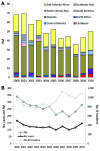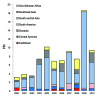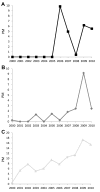Travel-associated illness trends and clusters, 2000-2010
- PMID: 23763775
- PMCID: PMC3713975
- DOI: 10.3201/eid1907.121573
Travel-associated illness trends and clusters, 2000-2010
Abstract
Longitudinal data examining travel-associated illness patterns are lacking. To address this need and determine trends and clusters in travel-related illness, we examined data for 2000-2010, prospectively collected for 42,223 ill travelers by 18 GeoSentinel sites. The most common destinations from which ill travelers returned were sub-Saharan Africa (26%), Southeast Asia (17%), south-central Asia (15%), and South America (10%). The proportion who traveled for tourism decreased significantly, and the proportion who traveled to visit friends and relatives increased. Among travelers returning from malaria-endemic regions, the proportionate morbidity (PM) for malaria decreased; in contrast, the PM trends for enteric fever and dengue (excluding a 2002 peak) increased. Case clustering was detected for malaria (Africa 2000, 2007), dengue (Thailand 2002, India 2003), and enteric fever (Nepal 2009). This multisite longitudinal analysis highlights the utility of sentinel surveillance of travelers for contributing information on disease activity trends and an evidence base for travel medicine recommendations.
Keywords: VFRs; case clusters; illness; surveillance; travel; trends; visiting friends and relatives.
Figures







References
-
- World Tourism Organization. UNWTO tourism highlights: 2011. edition [cited 2012 Aug 28]. http://mkt.unwto.org/sites/all/files/docpdf/unwtohighlights11enlr_1.pdf
-
- World Tourism Organization. Arrivals by purpose of visit [cited 2012 Aug 28]. Available from http://www.unwto.org/facts/eng/pdf/indicators/ITA_purpose04.pdf
Publication types
MeSH terms
Grants and funding
LinkOut - more resources
Full Text Sources
Other Literature Sources
Medical
